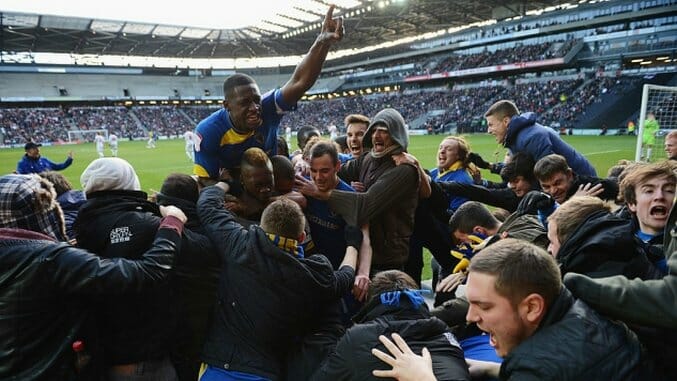Throwback Thursday: Milton Keynes vs AFC Wimbledon (December 2nd, 2012)
Photo by Michael Regan/Getty

Even a cursory study of British history will show that this damp island is no stranger to a good succession crisis. A monarch dies and his (or her, but historically speaking it’s usually been his) heirs argue over the right to sit on the throne next, and the ensuing slapfight ends up creating a political crisis, if not all-out war. Those kinds of conflicts don’t really happen anymore as far as the Crown is concerned, but you do find analogues in curious places.
Nearly 15 years ago a football club died. Two new clubs now claim they are the heirs to a legacy that stretches back over a century. One club has some legal documents and a 14-year-old certificate from the Football League. The other has a fanbase and a community in the predecessor club’s old neighborhood. One club claims legitimacy via the letter of the law, the other via the spirit of the game. Which club is the legitimate successor? How you answer that question says a lot about what you believe the point of this sport is.
Regardless of your answer, neither of these clubs are going anywhere. And now they’re both on the same level of the English football pyramid that they’ll have to reckon with one another on a semi-regular basis. Games between these two teams aren’t just clashes of bitter rivals; they’re proxy battles over the very soul of football.
This week we look back at the first meeting between Milton Keynes and AFC Wimbledon, and a drama as close to Shakespeare as anything you’d find in English football.
If you’ve been following the English game for any length of time there’s a good chance you’ve at least heard the story in passing. But just for posterity, let’s review quickly.
Wimbledon Football Club was founded in 1889 and spent most of its history in nonleague football. After some key successes, Wimbledon were elected to the Football League for the 1977-78 season. They then climbed their way up the ladder over the next decade or so and ultimately reached the old First Division. Along they way they pulled off one of the greatest FA Cup shocks in the competition’s history by beating Liverpool in the 1988 Final. In 1992 Wimbledon were among the 24 founding members of the Premier League, but the dawning era of big money in football plus the regulatory mandates from the Taylor Report left Wimbledon struggling to get by. Financial pressures forced them to abandon their home ground on Plough Lane, and when that wasn’t enough the owners sold the club to someone with more ambition. The new ownership group made it clear they had big plans for the club— and that those plans didn’t involve the fans or the community that nurtured it for more than a century.
After years of floating proposals and garnering broad recrimination from supporters, Wimbledon’s owners gained approval to move the club 60 miles north to the town of Milton Keynes. The club played their first match in Milton Keynes as Wimbledon FC in September 2003, and a year later had rebranded as Milton Keynes Dons. Meanwhile, the fans of the original club in South London made it clear they had no intention of following the ownership group to Buckinghamshire and announced their plans to form a new club, a move that the FA cited at the time as “not in the wider interests of football.” The fans-cum-directors held open tryouts on Wimbledon Common in the summer of 2002 and AFC Wimbledon fielded a team for the 2002-03 season in the Combined Counties League, the ninth division of English football. They earned five promotions over the next nine years, culminating in an emotional penalty shootout win over Luton Town in 2011 to win a place in the Football League.
While Milton Keynes had managed to finally develop some stability in League One, the 2012-13 season was rough for AFC Wimbledon. With just two wins and a draw from their first ten games of the season, the Wombles seemed to be in real danger of dropping out of the Football League after just two seasons. Relegations would be a huge blow to the club, not just financially but psychically. It would arrest the momentum they had built up over the past decade. Terry Brown, who led Wimbledon to promotion to the Football League, was let go in September. The following month he was replaced with Neal Ardley, who had played for the old Wimbledon in the 90s, in an bid to stop the rot and hopefully avoid relegation. Things had started to slowly pick up, although Ardley’s squad had to scrap for every point they could get their hands on. The team needed a jolt, something to shake out the cobwebs and build a sense of common purpose heading into the festive season and then the hard sprint toward the end of the campaign.
That jolt came in the form of the draw for the Second Round of the FA Cup. AFC Wimbledon’s replay win over York City in the First Round handed them a fateful tie, and a date the club and the fans had been dreading ever since their rebirth in 2002— a competitive match with Milton Keynes.
-

-

-

-

-

-

-

-

-

-

-

-

-

-

-

-

-

-

-

-

-

-

-

-

-

-

-

-

-

-

-

-

-

-

-

-

-

-

-

-








































